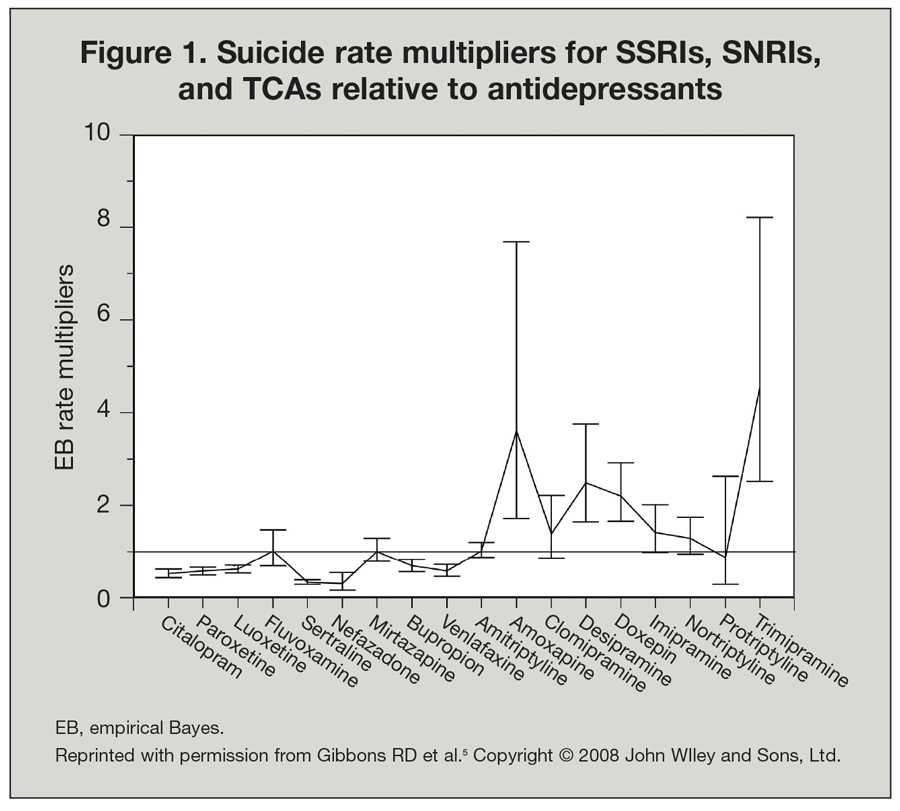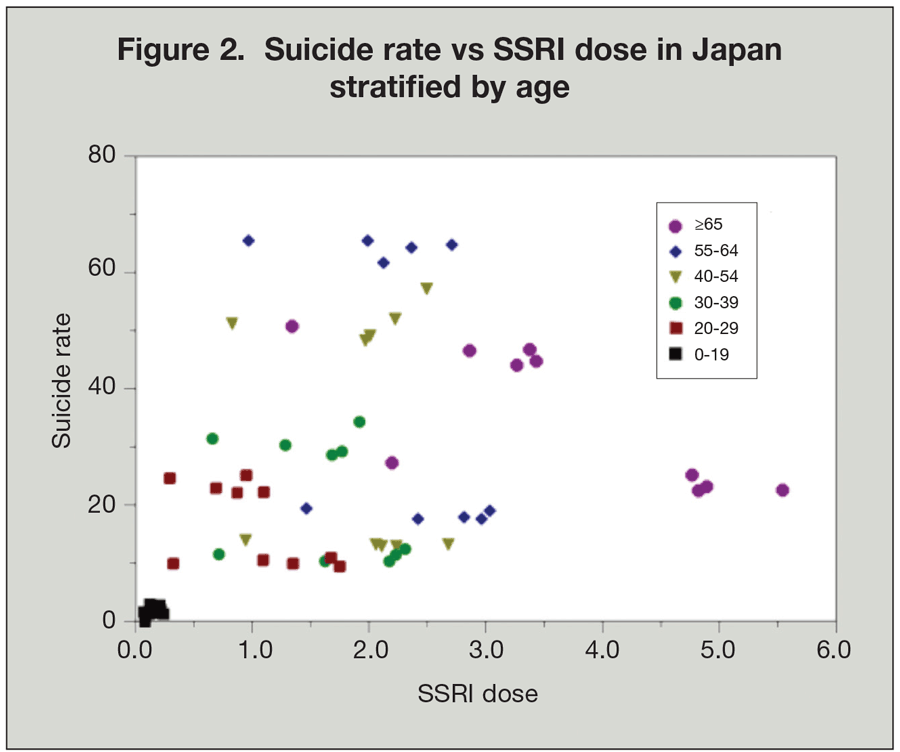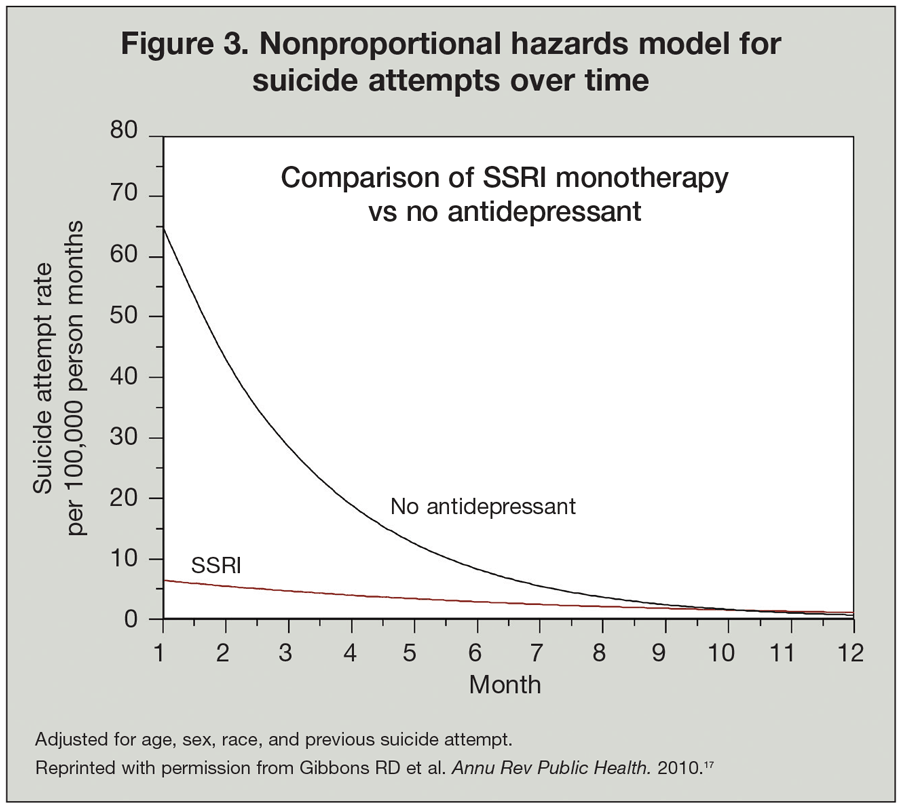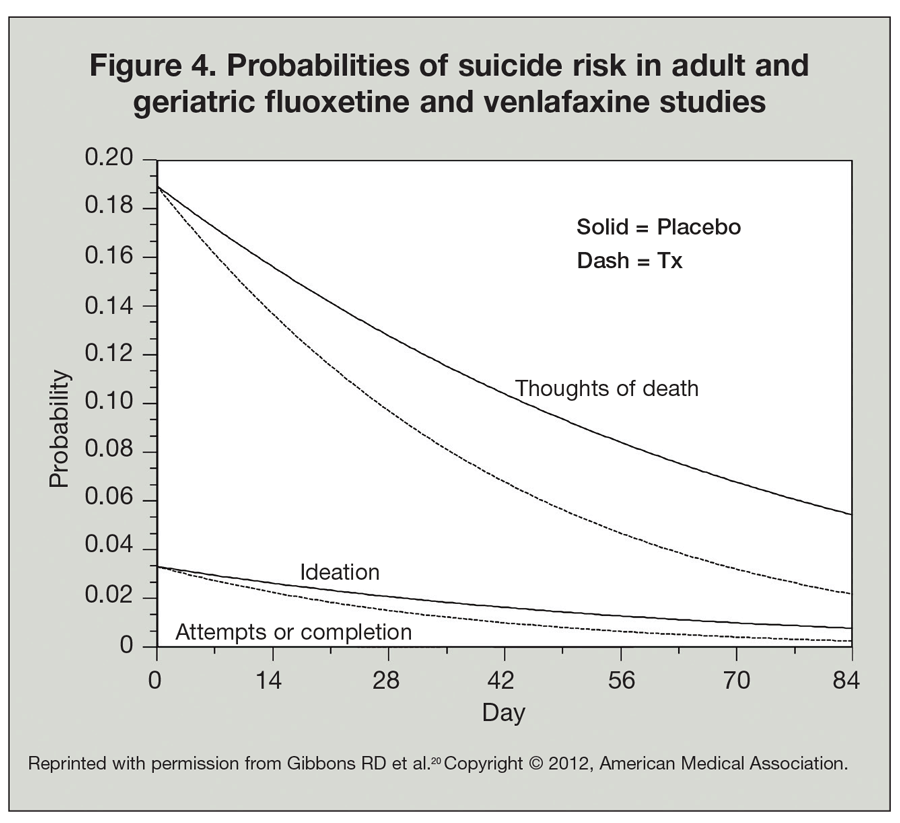Publication
Article
Psychiatric Times
The Relationship Between Antidepressant Initiation and Suicide Risk
Author(s):
Ten years ago, the FDA placed a black box warning on all antidepressants because of concerns that the medications increase risk of suicidal thoughts and behavior in youths. It's time for the FDA reevaluate that decision.
Figure 1. Suicide rate multipliers for SSRIs, SNRIs, and TCAs relative to antidepressants

Figure 2. Suicide rate vs SSRI dose in Japan stratified by age

Figure 3. Nonproportional hazards model for suicide attempts over time

Figure 4. Probabilities of suicide risk in adult and geriatric fluoxetine and venlafaxine studies

There has been much debate about whether certain classes of medications (eg, antidepressants) increase the risk of suicidal behavior and whether that risk is greater in children, adolescents, and young adults. In 2004, the FDA placed a black box warning on all antidepressants because of concerns that the medications increase risk of suicidal thoughts and behavior in youths; in 2006, the warning was extended to include young adults (up to age 26). The FDA based its black box warning on results of its meta-analyses of randomized controlled trials (RCTs) conducted in pediatric and adult psychiatric and nonpsychiatric populations.
History
Questions regarding a possible relationship between antidepressants and suicide were first raised in 1990 with the publication of a series of case reports in which the then newly introduced SSRIs were associated with the apparent emergence of suicidal thoughts and behavior.1 This led to FDA hearings in 1991, but no evidence of an increased risk of suicidal acts associated with antidepressants was found. In October 2004, concerns raised over paroxetine use in children and adolescents eventually led the FDA to issue a black box warning regarding antidepressants and suicide for children younger than 18 years.
The evidence supporting the first black box warning came from a meta-analysis that combined spontaneous reports of suicidal thoughts and behaviors from pediatric RCTs of newer antidepressants, mostly SSRIs.2 The risk of suicidal ideation and behavior, or suicidality, was found to be higher for children treated with antidepressants than for those given placebo (odds ratio [OR] = 1.78; 95% confidence interval [CI], 1.14, 2.77). The FDA also presented results of an analysis of prospective data (suicidal ideation or behavior rating-scale item) that showed no effect for emergence (OR: 0.93; 95% CI: 0.75, 1.15) or emergence and/or worsening of suicidal thoughts and behavior in the active-drug group compared with the placebo group (OR = 0.92; 95% CI, 0.76, 1.11).
The inconsistency between the prospective clinician ratings and spontaneous patient reports has not been adequately explained. It may be due to bias because patients randomized to active drug treatment have a greater likelihood of adverse effects in general, leading to more contact or conversation with study staff and increased chance of having any suicidal thoughts observed. Similarly, overdose on study medication is more likely to be reported if it results in the need for medical attention, as would be true for patients who receive active treatment rather than placebo.
Systematic questioning in a setting such as the emergency department or inpatient service generally gives a more accurate rate of suicidal ideation and behavior than do spontaneous reports. The FDA based its decision on the “signal” of risk from spontaneous adverse-event reports and not on the absence of a signal of risk from systematic clinician evaluations.
In January 2006, the FDA conducted a second meta-analysis of 372 RCTs of newer antidepressants in an adult population of approximately 100,000 patients.3 This analysis was based on spontaneous adverse-event reports from the RCTs and did not provide data from prospective clinician ratings. Overall, the analysis revealed no evidence of more suicide-related adverse reports in the antidepressant group than in the placebo group. Stratification by age showed that for the primary endpoint of suicidal ideation or behavior, for 18- to 24-year-olds, the risk was increased with medication compared with placebo, and the risk approached significance (OR = 1.62; 95% CI, 0.97, 2.71); for adults aged 25 to 64 years, the risk was significantly decreased (OR = 0.79; 95% CI, 0.64, 0.98); and for geriatric patients, the risk was markedly decreased (OR = 0.37; 95% CI, 0.18, 0.76) with antidepressants relative to placebo. On the basis of these results, the FDA extended the black box warning to cover 18- to 24-year-olds.
More recent data
Since the FDA warnings, studies have been conducted to explore the relationship between initiation of antidepressant treatment and suicidal events. We review several lines of evidence that range from the weakest data based on spontaneous reports to the most rigorous data based on RCTs.
Spontaneous reports. Spontaneous reports to the FDA can be made by anyone; most are from patients, physicians, pharmaceutical companies, and plaintiff attorneys. They report both an adverse event and a listing of one or more medications that a patient is taking at the time of the event. Use of the spontaneous reporting systems for drug safety determination is highly problematic. Some limitations regarding these data are:
• Confounding by indication (ie, patients taking a particular drug may have a disease that is itself associated with a higher incidence of the adverse event)
• Systematic underreporting
• Effects of publicity in the media on numbers of reports
• Duplication of reports
• Attribution of the event to a single drug when patients may be taking multiple drugs
• Missing data
These limitations degrade the capacity for optimal data mining and analysis, and any conclusions must be tentative and require validation by another data source.4
Data from the FDA Adverse Event Reporting System (MedWatch) from 1998 to 2004 for all antidepressants and completed suicide were analyzed by our group.5 The dataset comprised a total of 28,317,382 records, including all reported adverse events and drug combinations. A national prescription rate for each antidepressant by year is the denominator in the analysis. Figure 1 presents a plot of the estimated rate multipliers and confidence limits for each drug. As a class, both SSRIs and SNRIs have rate multipliers that are significantly less than 1.0 (ie, lower than the national average suicide adverse-event report rate for antidepressants as a class). By contrast, TCAs have rate multipliers that are significantly above the national average suicide rate for antidepressants. TCAs have a significantly higher risk of suicide adverse-event reports than do SSRIs and SNRIs.
This is striking because one might anticipate an increase in reports related to SSRIs given the highly publicized concern over a possible link between suicide and the use of SSRIs. However, TCAs are much more toxic than SSRIs on overdose and are much more likely to produce a medically serious outcome. Therefore, it may be important to separate reports of medically serious overdoses using TCAs or SSRIs. Comparing the incidence of other types of suicide-related reports for these classes of medication may clarify the situation.
Ecological studies. For very rare events, such as those that occur at rates of 1 in 10,000 or less (eg, death by suicide), there are few options for routine drug surveillance because very large populations of patients are needed to detect enough events to be informative. One approach is to use ecological data that relate changes in drug prescription rates to suicide rates in large populations.
Decreases in suicide rate over time have been shown to correlate with increased antidepressant use in many studies around the world, including those in Europe, Scandinavia, the US, and Australia. In Sweden, the doubling of prescriptions for SSRIs correlated with a 25% decrease in the suicide incidence.6 In an analysis of 27 countries, Ludwig and Marcotte7 showed that an increase of 1 pill per capita (a 13% increase over 1999 levels) was associated with a 2.5% reduction in suicide rates, a relationship that was more pronounced in adults than in children.
Japan is a curious anomaly. Researchers there found a positive association between suicide rates and antidepressant prescriptions.8Figure 2 clearly shows an overall positive association between SSRI prescriptions and suicide rates; however, stratification by age reveals that within each age stratum, an inverse association is observed. This is a classic illustration of Simpson’s paradox. What it indicates is that in Japan, both suicide rates and use of antidepressants increase with age; however, for a given age-group, suicide rates have decreased with increasing SSRI prescriptions over time.
Another anomaly is Iceland, where antidepressant prescription rates seemed unrelated to lower suicide rates. Part of the reason for this are the traditionally extremely low suicide rates in Iceland. This is a floor effect; there is so little room for a further decline in suicide rates that the relationship to prescription rates is extremely hard to detect. Italy has had a decline in suicide rates linked to prescriptions for women but not for men. Most antidepressants in Italy are prescribed for women, and so the ability to detect such a relationship is greater in women.
Ecological modeling from large numbers of small areas can also provide a stronger basis for understanding the association between antidepressant medication use and suicide completion. US county-level data on suicide rates and antidepressant prescription rates were analyzed for 1996 to 1998.9 After adjusting for sex, race, age, income, and unobservable county-level effects, the analyses revealed that increases in SSRI and SNRI prescriptions were associated with decreases in suicide rates both between and within counties over time. Conversely, counties with higher rates of TCA prescriptions were associated with higher suicide rates; this may be because of the greater toxicity of this class of agents and/or their more frequent use in areas with poorer access to quality mental health services. This finding has been replicated in children and young adolescents (aged 5 to 14 years) and indicates that the relationship is robust and manifest across the life cycle, from childhood to adulthood.10
Large-scale observational studies. Valuck and colleagues11 examined the effects of antidepressants on 24,119 adolescents with a first diagnosis of major depression. At least 6 months of follow-up data were available, which showed that treatment with SSRIs, other antidepressants, or combinations of antidepressants did not increase the risk of suicide attempts. Similar results were seen by Simon and colleagues.12,13
In contrast, Olfson and associates14 conducted a case-control study in depressed children and found a significant association for both suicide attempts (n = 263) and suicide completion (n = 8) in children treated with antidepressants. Tiihonen and colleagues15 found that current antidepressant use was associated with increased risk of suicide attempts but lower risk of suicide completion in youths who had been treated with an antidepressant.
A cohort study of 226,866 veterans with newly diagnosed depression indicated that the attempted suicide rate was lower in those treated with only an SSRI (monotherapy) than in those who did not receive an antidepressant (123/100,000 vs 335/100,000, respectively; OR = 0.37; 95% CI, 0.29, 0.47).16 In SSRI-treated patients, the rate of suicide attempts was lower after treatment (123/100,000) than before treatment (221/100,000; relative risk = 0.56; 95% CI, 0.44, 0.71). Analyses stratified by age showed that the benefit for 18- to 24-year-olds was comparable to that for the older age-groups: this contrasts with the FDA findings of greater risk in young adults that prompted the extension of the black box warning to include this age-group.
These data have been reanalyzed using discrete-time survival analysis and showed a robust decrease in suicide attempt rate with SSRI monotherapy (hazard ratio = 0.17; 95% CI, 0.10, 0.28).17 As shown in Figure 3, the incidence of attempted suicide decreased concurrently with time from the index episode, and the hazard rate was much lower for treated patients during the first few months following treatment initiation; however, the difference becomes indistinguishable by 9 months following the index episode. The lack of detectable benefit 9 months later may reflect a combination of spontaneous remission of major depression in the placebo group and declining compliance over time with treatment in the medicated group.
Randomized controlled trials. Bridge and colleagues18 analyzed an expanded set (27 studies) of pediatric RCTs of antidepressant treatment and suicidality and found less correlation between the two than the FDA’s original findings. Their report used a larger data set than the FDA’s and found a more favorable risk to benefit ratio.
In our research synthesis of longitudinal data, fluoxetine in youths, adults, and the elderly and venlafaxine in adults were shown to be efficacious in all age-groups. Children experienced the maximum benefit and the elderly only marginal benefit following 6 weeks of treatment.19,20 Adults and the elderly had significant benefit from antidepressant treatment in terms of reduction of suicidal thoughts and behavior; however, this improvement was mediated by a decrease in depressive severity. Figure 4 reveals that over time in both treated and control patients, there was a decrease in the frequency of suicidal thoughts and behavior; however, the decrease was significantly more pronounced in patients randomized to antidepressant treatment.
The magnitude of the difference between active treatment and control in terms of suicidal thoughts and behavior increases over time in adults and the elderly; however, there was no effect of treatment on suicidal thoughts and behavior in children, despite statistically and clinically significant benefits in terms of depression observed with active treatment. These findings suggest that suicidal thoughts and behavior in adults are largely driven by depression severity; however, this does not appear to be the case for children.
Clinicians who treat adults need to focus on maximizing the degree of improvement in depression to maximize the decrease in suicidal ideation and thereby acute suicide risk. These findings are consistent with a recent report in which most suicidal adolescents (more than 80%) received some form of mental health treatment, but such treatment failed to prevent suicidal behavior from occurring.21
What happened following the black box warning?
Ecological studies revealed that there may have been unintended consequences of the black box warning. Evidence now shows that antidepressant prescription rates dropped precipitously beginning with the public health advisory in March 2004, which preceded the black box warning in October 2004. Since the initial public health advisory, antidepressant prescriptions for children and adolescents decreased, with a consequent increase (14%) in incidence of suicide in these populations.22,23 No increase in suicide was found in the elderly, for whom antidepressant prescription rates continued to increase.
Libby and colleagues24,25 found significant decreases in the number of new cases of child and young adult depression that were diagnosed by general practitioners following the black box warning (44% reduction in pediatric patients and 37% in young adults). Isacsson and Ahlner26 looked at 845 suicides in the 10- to 19-year-old group in Sweden from 1992 through 2010. After the 2004 warning, the suicide rate increased for 5 consecutive years (60.5%), largely in those who were not treated with antidepressants.
Busch and colleagues27 studied academic and behavioral outcomes in more than 100,000 adolescents aged 12 to 17 using a difference-in-difference design. They found that grade point averages (GPAs) for depressed children decreased 0.20 points following the black box warning in the US; however, there was no change in GPAs in non-depressed children. They also found increases in delinquency and use of tobacco and illicit drugs among depressed adolescents.
The FDA implementation of a black box warning had the purpose of reducing suicide rates in children, adolescents, and young adults. The picture following the FDA warning and implementation of the black box warning is not that of a lower suicide rate as intended or hoped for by the FDA. Instead, we see fewer antidepressant prescriptions, an increase in youth suicides, and negative effects on human capital. That outcome is difficult to reconcile with a model of an increase in youth suicide risk when antidepressants are prescribed. The findings fit better with a model of a net reduction in suicide risk when antidepressants are prescribed.
Summary
The data show that in adults, antidepressants appear to protect against suicidal events. SSRIs are associated with lower overall suicide rates compared with other classes of antidepressants (eg, TCAs). Antidepressants are effective in reducing symptoms, which, in turn, mediates suicidal events in adults and the elderly. This does not appear to be the case for youths, for whom antidepressant medications can reduce the severity of depression but appear to have no effect one way or the other on suicidal thoughts and behavior. Conversely to what is seen in adults, it may be that aggressive-impulsive traits play a more important role in youth suicide than does depressed mood. The impact of antidepressants on these traits remains unclear. Youth suicide may also be potentially related to illicit drug use and social factors, such as bullying, that are not directly affected by antidepressants.
The black box warning and the earlier public health advisory have shown that discouraging the medication treatment of depression in children is not an effective solution in preventing suicidal behavior. Careful monitoring and treatment of depression and monitoring suicide risk in children is clearly essential. Overall, the clinical evidence is that the majority of patients, young and old, benefit from antidepressants, without increased risk of suicide.
Ten years after the introduction of the black box warning, it is time that the FDA reevaluates this decision and that the results be made public. Moreover, the labeling language should be rewritten to clearly delineate the risks of treatment compared with the risks of no treatment.
Disclosures:
Dr Gibbons is Professor of Biostatistics in the departments of medicine, public health sciences, and psychiatry, and Director of the Center for Health Statistics at the University of Chicago. Dr Mann is the Paul Janssen Professor of Translational Neuroscience in the department of psychiatry at Columbia University, and Director, Molecular Imaging and Neuropathology Division, the New York State Psychiatric Institute, New York. The authors report no conflicts of interest concerning the subject matter of this article.
References:
1. Teicher MH, Glod C, Cole JO. Emergence of intense suicidal preoccupation during fluoxetine treatment. Am J Psychiatry. 1990;147:207-210.
2. Hammad TA, Laughren T, Racoosin J. Suicidality in pediatric patients treated with antidepressant drugs. Arch Gen Psychiatry. 2006;63:332-339.
3. Food and Drug Administration. Clinical review: relationship between antidepressant drugs and suicidality in adults. http://www.fda.gov/ohrms/dockets/ac/06/briefing/2006-4272b1-01-FDA.pdf. Accessed November 5, 2014.
4. Hauben M, Riech L, DeMicco J, Kim K. ‘Extreme duplication’ in the US FDA adverse events reporting system database. Drug Saf. 2007;30:551-554.
5. Gibbons RD, Segawa E, Karabatsos G, et al. Mixed-effects Poisson regression analysis of adverse event reports: the relationship between antidepressants and suicide. Stat Med. 2008;27:1814-1833.
6. Isacsson G. Suicide prevention-a medical breakthrough? Acta Psychiatr Scand. 2000;102:113-117.
7. Ludwig J, Marcotte DE. Anti-depressants, suicide, and drug regulation. J Policy Anal Manage. 2005;24:249-272.
8. Nakagawa A, Grunebaum MF, Ellis SP, et al. Association of suicide and antidepressant prescription rates in Japan, 1999-2003. J Clin Psychiatry. 2007;68:908-916.
9. Gibbons RD, Hur K, Bhaumik DK, Mann JJ. The relationship between antidepressant medication use and rate of suicide. Arch Gen Psychiatry. 2005;62:165-172.
10. Gibbons RD, Hur K, Bhaumik DK, Mann JJ. The relationship between antidepressant prescription rates and rate of early adolescent suicide. Am J Psychiatry. 2006;163:1898-1904.
11. Valuck RJ, Libby AM, Sills MR, et al. Antidepressant treatment and risk of suicide attempt by adolescents with major depressive disorder: a propensity-adjusted retrospective cohort study. CNS Drugs. 2004;18:1119-1132.
12. Simon GE, Savarino J, Operskalski B, Wang PS. Suicide risk during antidepressant treatment. Am J Psychiatry. 2006;163:41-47.
13. Simon GE, Savarino J. Suicide attempts among patients starting depression treatment with medications or psychotherapy. Am J Psychiatry. 2007;164:1029-1034.
14. Olfson M, Marcus SC, Shaffer D. Antidepressant drug therapy and suicide in severely depressed children and adults: a case-control study. Arch Gen Psychiatry. 2006;63:865-872.
15. Tiihonen J, Lönnqvist J, Wahlbeck K, et al. Antidepressants and the risk of suicide, attempted suicide, and overall mortality in a nationwide cohort. Arch Gen Psychiatry. 2006;63:1358-1367.
16. Gibbons RD, Brown CH, Hur K, et al. Relationship between antidepressants and suicide attempts: an analysis of the Veterans Health Administration data sets. Am J Psychiatry. 2007;164:1044-1049.
17. Gibbons RD, Amatya AK, Brown CH, et al. Post-approval drug safety surveillance. Annu Rev Public Health. 2010;31:419-437.
18. Bridge JA, Iyengar S, Salary CB, et al. Clinical response and risk for reported suicidal ideation and suicide attempts in pediatric antidepressant treatment: a meta-analysis of randomized controlled trials. JAMA. 2007;297:1683-1696.
19. Gibbons RD, Hur K, Brown CH, et al. Benefits from antidepressants: synthesis of 6-week patient-level outcomes from double-blind placebo-controlled randomized trials of fluoxetine and venlafaxine. Arch Gen Psychiatry. 2012;69:572-579.
20. Gibbons RD, Brown CH, Hur K, et al. Suicidal thoughts and behavior with antidepressant treatment: reanalysis of the randomized placebo-controlled studies of fluoxetine and venlafaxine [published correction appears in Arch Gen Psychiatry. 2013;70:881]. Arch Gen Psychiatry. 2012;69:580-587.
21. Nock MK, Green JG, Hwang I, et al. Prevalence, correlates, and treatment of lifetime suicidal behavior among adolescents: results from the National Comorbidity Survey Replication Adolescent Supplement. JAMA Psychiatry. 2013;70:300-310.
22. Gibbons RD, Brown CH, Hur K, et al. Early evidence on the effects of regulators’ suicidality warnings on SSRI prescriptions and suicide in children and adolescents. Am J Psychiatry. 2007;164:1356-1363.
23. Centers for Disease Control and Prevention. Suicide trends among youths and young adults aged 10-24 years-United States, 1990-2004. MMWR Morb Mortal Wkly Rep. 2007;56:905-908.
24. Libby AM‚ Brent DA‚ Morrato EH‚ et al. Decline in treatment of pediatric depression after FDA advisory on risk of suicidality with SSRIs. Am J Psychiatry. 2007;164:884-891.
25. Libby AM, Orton HD, Valuck RJ. Persisting decline in depression treatment after FDA warnings. Arch Gen Psychiatry. 2009;66:633-639.
26. Isacsson G, Ahlner J. Antidepressants and the risk of suicide in young persons-prescription trends and toxicological analyses. Acta Psychiatr Scand. 2014;129:296-302.
27. Busch SH, Golberstein E, Meara E. The FDA and ABCs: unintended consequences of antidepressant warnings of adolescent human capital. J Hum Resour. 2014;49:540-571.






